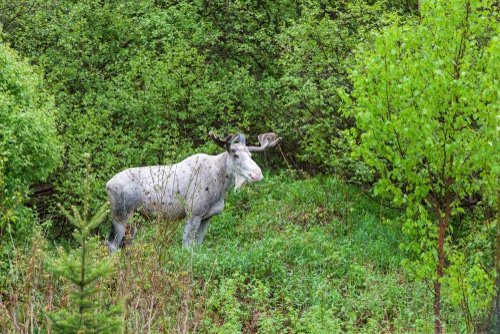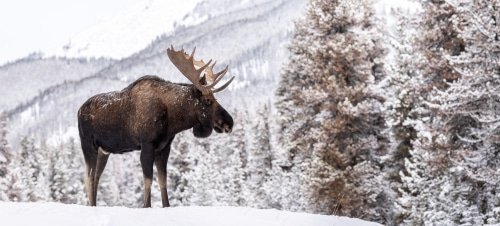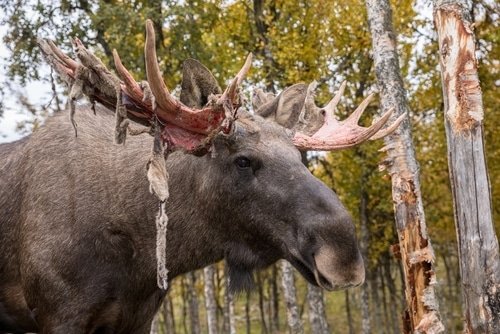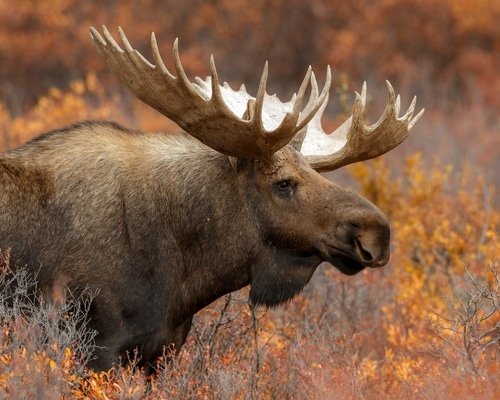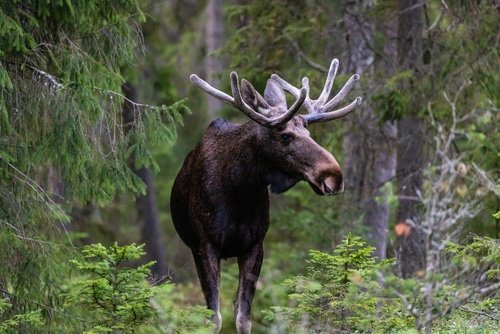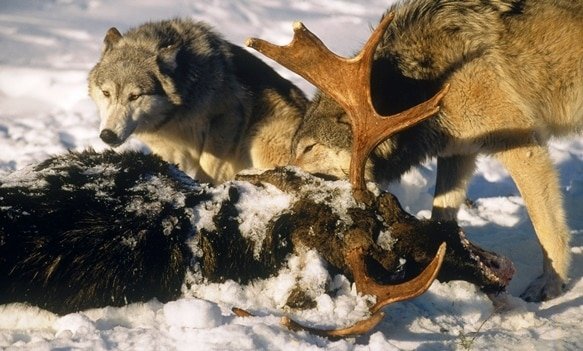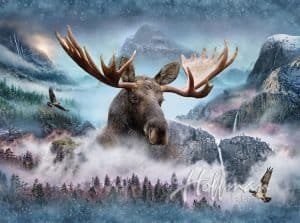The white moose, also known as the albino moose or rare moose colors, is a breathtaking creature that captures the imagination of all who see it. What sets this magnificent animal apart from its more commonly colored counterparts is its stunning white coat. This striking feature, which results from a genetic mutation, gives the white moose an ethereal appearance that has fascinated humans throughout history.
A Closer Look at the Appearance
Picture a massive, regal creature wandering through dense forests with snow-white fur glistening under dappled sunlight. The white moose boasts an extraordinary beauty that evokes a sense of awe and wonder in those fortunate enough to witness it.
Its pristine coat lacks pigmentation, displaying a pure whiteness from head to toe. From its majestic antlers reaching towards the sky to its elegant facial features and sturdy frame, every aspect of this creature’s appearance commands attention and leaves a lasting impression.
Rarity and Symbolism in Folklore and Culture
Throughout history, encounters with white moose have been exceedingly rare, making them objects of fascination and reverence across cultures worldwide. These mystical creatures have often been regarded as harbingers of good fortune or spiritual significance by indigenous communities, who see them as symbols of purity and grace.
Their scarcity has elevated their status in folklore as creatures embodying magic or mythical qualities. The allure surrounding these elusive beings has inspired artistic representations, literature, and legends passed down through generations.
The introduction sets the stage for exploring the mesmerizing world of white moose by defining their physical and cultural characteristics. It highlights their natural rarity while emphasizing their profound significance in folklore and cultural symbolism across different societies.
The Genetics behind White Moose
Explanation of Genetic Mutation Causing White Coat Color
Have you ever wondered why some moose have a striking white coat instead of the usual brownish hue? Well, my friend, it all comes down to a fascinating genetic mutation. You see, the white coloration in moose is caused by a recessive gene known as the MC1R gene, which controls pigmentation.
This gene mutation inhibits melanin production, resulting in the absence of pigment and giving these majestic creatures their unique snowy appearance. You might think, “Isn’t a white moose just an albino moose?” But hold your horses!
Unlike albino animals that lack all pigment in their skin, hair, and eyes (and often have pinkish eyes), white moose still retain dark-colored eyes and hooves. It’s quite a sight to behold!
Frequency and Inheritance Patterns of the Gene Mutation
White moose are undeniably rare treasures in the animal kingdom. The occurrence of this striking color variation is estimated to be around 1 in 30,000 individuals within populations of North American and European moose species. While this may seem like finding a needle in a haystack, it’s important to note that these numbers can vary depending on specific regions and subspecies.
When it comes to inheritance patterns, things get even more intriguing! This recessive gene responsible for white coat color can only manifest when both parents carry it.
If mama and papa moose possess this special gene variant, then there’s about a 25% chance their baby will be born with that mesmerizing coat of pure whiteness. However, if only one parent carries the gene while the other doesn’t (we call them carriers), there’s still hope for lighter shades among their offspring.
Nature sure has a way of surprising us with its rare moose colors and the intricate workings of genetics. It’s truly a marvel to witness these magnificent creatures roaming the wild with their stunning white coats, standing out in stark contrast to their surroundings.
Habitat and Distribution
Overview of the natural habitats preferred by white moose
White moose are majestic creatures that can be found inhabiting various environments. They are particularly fond of boreal forests, taiga regions, and wetlands. These habitats offer an abundance of vegetation, such as water lilies, aquatic grasses, willows, and birch trees – all of which form a significant part of their diet.
The dense forests provide ample cover and shade during hot summers while protecting from harsh winter conditions. White moose have also been spotted near freshwater lakes and rivers, where they take advantage of the rich aquatic foliage.
Geographical distribution and population estimates
White moose are primarily found in the northern regions of North America and Europe. In North America, they can be observed in areas such as Alaska, Canada (particularly Newfoundland and Labrador), Sweden, Norway, Finland, Estonia, Russia, and parts of Belarus. However, it’s essential to note that their numbers remain relatively small compared to their brown counterparts.
Population estimates are difficult to accurately determine due to the elusive nature of white moose and their naturally low numbers. Nevertheless, conservation efforts have helped shed light on their population trends and distribution patterns, which aid in safeguarding these remarkable creatures for future generations.
Note: While “albino moose” is commonly used colloquially when referring to white moose due to their similar appearance, it’s important to clarify that true albinism is rare among these animals. The white coloration is primarily caused by a genetic mutation that results in reduced pigmentation rather than complete absence.
Adaptations for Survival
Master of Disguise: Camouflage Techniques
With their ethereal and magical appearance, white moose may seem conspicuous in the wild. However, they possess remarkable camouflage techniques that help them blend seamlessly with their surroundings.
Their light-colored coats, varying from pure white to a mottled mix of white and gray, allow them to disappear among the snow-covered landscapes of their habitats. The remarkable adaptation lies in both the color and texture of their fur.
The coarse guard hairs on their backs create an illusion of shadows against the snow, while the softer underfur is insulating but also helps scatter light, making them appear almost invisible to predators or curious onlookers. These rare moose colors are a key survival strategy that allows them to move undetected through their environment.
Avoiding Predators: The Art of Evading Danger
Survival in the wild demands effective camouflage and behavioral adaptations to avoid encounters with predators. White moose have developed certain strategies to minimize potential threats. Their keen senses provide early warnings when danger lingers nearby; acute hearing and a heightened sense of smell aid in detecting predators such as wolves or bears before they get too close.
When faced with potential danger, these majestic creatures will often freeze in place while keeping a vigilant eye on their surroundings. By remaining still, they become less noticeable amidst the white landscape, allowing them precious moments to assess whether it’s necessary to engage in further evasive action or slowly retreat from harm’s way.
These adaptations demonstrate how white moose have evolved incredible survival mechanisms that enhance their chances against natural environmental threats. From blending seamlessly with snowy landscapes to employing strategic behaviors when danger lurks nearby – these unique creatures are masters at staying one step ahead in nature’s perpetual game of cat-and-mouse.
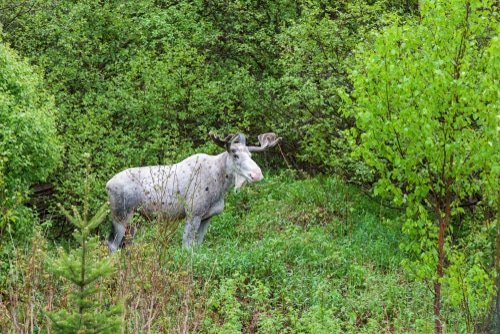
Diet and Feeding Habits
Food Sources for White Moose, Including Aquatic Plants
Regarding their diet, white moose aren’t exactly picky eaters. These majestic creatures have a wide range of preferred food sources. One of their absolute favorites is aquatic plants.
Whether it’s lily pads or water lilies, these green goodies are like a gourmet meal for them. You can often find white moose wading through shallow waters with their long legs, gracefully nibbling on these aquatic delicacies.
It’s truly a sight to behold! But don’t be fooled by their selective taste for water-based cuisine; they also enjoy feasting on various shrubs, grasses, and tree bark.
Feeding Strategies During Different Seasons
Like any other animal in the wild, white moose have to adapt their feeding strategies based on the seasons. During spring and summer, when the forests are lush with foliage, they take advantage of this abundance and graze leisurely throughout the day.
They browse on tender leaves and twigs, making sure to get all the necessary nutrients for growth and survival. However, when winter comes knocking with its cold winds and heavy snowfall, food becomes scarce, and reaching those delectable leaves becomes challenging.
So what do our resilient white moose do? They resort to browsing on tree bark!
Yes, you heard that right – these magnificent creatures will strip off strips of bark from trees using their strong teeth to sustain themselves during those harsh winter months. White moose have diverse palates but show a particular fondness for aquatic plants.
Their feeding habits adapt according to the seasons as they indulge in fresh greens during warmer months but resort to bark consumption in winter when foliage is limited. These eating patterns allow them to thrive in challenging environments while maintaining their unique charm as rare moose colors.
Social Structure and Reproduction
The social structure of white moose revolves around family dynamics and reproductive behaviors. Within a group of white moose, dominant males, also known as bulls, play a vital role during the mating season.
These magnificent creatures engage in intense battles to establish dominance and gain access to females for mating. The strongest bull among them earns the right to mate with multiple females, ensuring the survival of their genes.
In contrast, female white moose exhibit a hierarchical structure within their ranks. The older and more experienced cows hold higher positions and have priority access to resources such as feeding grounds or water sources.
Additionally, female moose display nurturing behavior towards their calves. They fiercely protect them from threats and teach them essential survival skills in their challenging environment.
Threats to the White Moose Population
Despite their captivating presence, white moose face various threats that endanger their population. Human activities such as deforestation and pollution significantly impact their natural habitats. As forests are cleared for urban expansion or industrial activities, the availability of suitable food sources diminishes, along with potential hiding spots from predators.
Moreover, illegal hunting practices targeting rare animals like the white moose pose a severe threat to their existence. Poachers often exploit the rarity of these majestic creatures by targeting them for trophies or illegally selling body parts on black markets.
Conservation Efforts
Several conservation efforts have been put in place to safeguard the future of white moose populations. National parks and protected areas are established with a dedicated focus on preserving pristine habitats where these remarkable creatures can thrive undisturbed.
By designating specific regions as protected zones, authorities ensure that the white moose and their ecosystems remain shielded from destructive human activities. Furthermore, research initiatives are underway to study the genetics and behavior of white moose.
Scientists aim to comprehensively understand these rare moose colors and their adaptations, allowing for informed conservation strategies. By unraveling the mysteries surrounding white moose, researchers hope to contribute valuable insights into preserving their populations for future generations.
Fascinating Facts about White Moose
Throughout history, numerous fascinating accounts of encounters with white moose have existed. Historical records document awe-inspiring moments when individuals witnessed these ethereal creatures in the wild.
These remarkable sightings have captivated explorers, artists, and nature enthusiasts, leaving an indelible mark on human imagination. Moreover, white moose holds cultural significance in indigenous communities.
They are often revered as sacred animals or considered spiritual symbols of power and purity. The albino moose is believed to possess extraordinary qualities that transcend the physical realm, connecting humanity with the mystical forces of nature.
Conclusion
The world of white moose is enchanting, embodying both natural wonder and cultural significance. However, their population faces threats from habitat destruction and illegal hunting practices. Fortunately, conservation efforts and scientific research are working towards securing their future in a world where these rare creatures can continue to inspire awe and evoke a sense of wonder in future generations.

